Reading
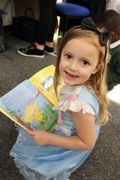 At Gray’s Farm we love reading and so do our pupils. We are passionate about instilling a love of reading within our children and we work tirelessly to ensure that reading is a subject they love.
At Gray’s Farm we love reading and so do our pupils. We are passionate about instilling a love of reading within our children and we work tirelessly to ensure that reading is a subject they love.
Reading takes place continuously throughout the school day, and as well as being taught as an individual subject, you will also see it embedded across all aspects of the curriculum. Skills such as inference and deduction are taught, as well as grammatical and punctuation conventions. Vocabulary is a key part of our reading sessions as we believe broadening a child’s language helps them to understand and communicate in more developed ways.
Here’s a glimpse at when focused reading happens within our school:
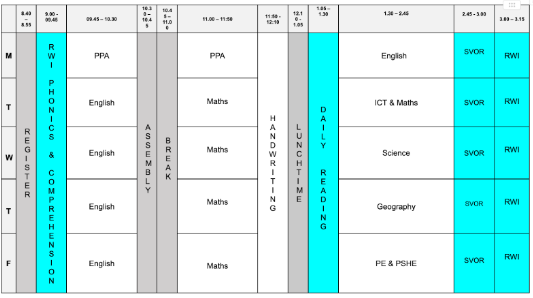
We also celebrate and enjoy reading as a school in the following ways:
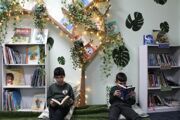
Reading Assembly – each week we host an assembly completely dedicated to reading, where we celebrate Star Readers, play the ‘Masked Reader’, discuss book recommendations and much more.
Book Ven ding Machine - we are very excited to have our very own vending machine full to the brim with a range of books which our pupils have the chance to win! To receive a golden coin for our vending machine, children take part in our reading challenge which encourages pupils to read at home every day.
ding Machine - we are very excited to have our very own vending machine full to the brim with a range of books which our pupils have the chance to win! To receive a golden coin for our vending machine, children take part in our reading challenge which encourages pupils to read at home every day.
Reading Hut - because we know that reading can take place anywhere, we have created reading huts on our playgrounds so that children have the opportunity to find a comfy spot and enjoy a book on their own or with their peers.
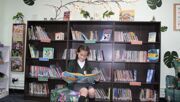 Library – At Gray’s Farm we have a brand new, recently revamped library that has been created together by staff and pupils. We listened to what our pupils said about the types of books they’d like to read and the kind of environment they wanted to read in and as a result we now have an amazing library full of books and lots of huge bean bags so that our children can grab a book and find a cosy spot to enjoy it in! On the walls of the library you will see book recommendations written by our pupils, as well as book reviews just in case you need a little inspiration with your next book choice. And if you feel like you need a new reading challenge, do not fear! Our book collection is always being added to; you will find our latest arrivals on our ‘Bookflix’ display in the main school corridor.
Library – At Gray’s Farm we have a brand new, recently revamped library that has been created together by staff and pupils. We listened to what our pupils said about the types of books they’d like to read and the kind of environment they wanted to read in and as a result we now have an amazing library full of books and lots of huge bean bags so that our children can grab a book and find a cosy spot to enjoy it in! On the walls of the library you will see book recommendations written by our pupils, as well as book reviews just in case you need a little inspiration with your next book choice. And if you feel like you need a new reading challenge, do not fear! Our book collection is always being added to; you will find our latest arrivals on our ‘Bookflix’ display in the main school corridor.
World Book Days
At Gray's Farm we love World Book Day! Each year, a fun-filled day is planned for our pupils, with the whole school taking part in a range of activities to celebrate! From a 'Whodunnit' mystery to a whole school Mr Men Party, it's always an eventful day! This year our theme was ‘Mixed Up Book Characters’ with the challenge to come dressed as not one, but two of your favourite book characters! Take a look below at some of our costume winners this year.
Well done to everyone for your fantastic costumes – you did us all proud!

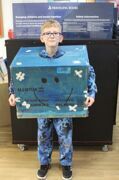
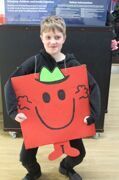
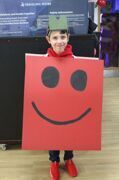
Simple View of Reading
Simple View of Reading happens every day for 20 minutes. These sessions provide children with an opportunity to sit quietly and read a book. During these sessions, staff read with individual children or a focus group of children. Children are set reading targets and discussions take place on their reading, including their reading at home, whether they enjoy reading and whether any extra support needs to be put in place to help them succeed with their reading.
Accelerated Reader
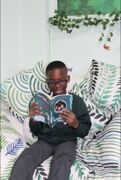 In conjunction with our dedicated teaching, we use ‘Accelerated Reader’ to give children the opportunity to delve into new books independently while building reading speed and fluency. Accelerated Reader is a fantastic programme which allows children to read books within their ZPD (Zone of Proximal Development). By reading within their ZDP, children are able to access the texts, enjoy the storylines while still making progress.
In conjunction with our dedicated teaching, we use ‘Accelerated Reader’ to give children the opportunity to delve into new books independently while building reading speed and fluency. Accelerated Reader is a fantastic programme which allows children to read books within their ZPD (Zone of Proximal Development). By reading within their ZDP, children are able to access the texts, enjoy the storylines while still making progress.
This video for our pupils lets them know why Accelerated Reader is so important and what they need to do to succeed at it!
This informational video for parents will give you an insight into how you can help your child with their Reading on Accelerated Reader.
Assessment
Star Reader - These assessments allow teachers to monitor reading progress and plan lessons according to the exact needs of the children in their class. Children take part in these assessments every half term and actually often look forward to them as they get to find out whether they have moved up a ZPD level. The ZPD level is a book range that is given to the children so that they can choose books (on myON, from the library or in their classroom) that match up to their reading ability. We believe that this is so important as it encourages a love of reading, as they read books that they can access. The best thing about the ZPD range is that it is exactly that – a range! This means that when children are given a new ZPD they are able to choose a book in the middle of their range and then as they gain confidence, we encourage them to challenge themselves and pick a book/s from the top end of their ZPD.
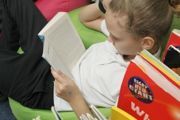 Reading catch ups – because we recognise the value of having regular conversations with our pupils about what they are reading, we have weekly ‘catch ups’ timetabled in between teachers and pupils. These are opportunities for us to hear them read, discuss their book choice and talk through any barriers to reading that they may be facing. As well as this, we also have specific members of staff who work across all classes with the task of identifying any children who might need extra support choosing a correctly levelled book, as well as helping to identify those who would benefit from extra reading support. We whole heartedly believe that these conversations are so valuable and we have seen the impact of them on our pupils, who are now confident at discussing their ZPD and book choice with anyone who asks.
Reading catch ups – because we recognise the value of having regular conversations with our pupils about what they are reading, we have weekly ‘catch ups’ timetabled in between teachers and pupils. These are opportunities for us to hear them read, discuss their book choice and talk through any barriers to reading that they may be facing. As well as this, we also have specific members of staff who work across all classes with the task of identifying any children who might need extra support choosing a correctly levelled book, as well as helping to identify those who would benefit from extra reading support. We whole heartedly believe that these conversations are so valuable and we have seen the impact of them on our pupils, who are now confident at discussing their ZPD and book choice with anyone who asks.
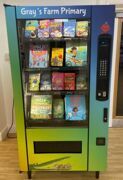 Reading Challenge – to encourage our children with their reading and to celebrate progress, we run the ‘Reading Challenge’ throughout the school. All children are given a challenge card to complete in class which outlines what they need to do in order to complete the challenge. When children have completed their challenge card they receive a gold coin which they are able to cash in and receive their very own book!
Reading Challenge – to encourage our children with their reading and to celebrate progress, we run the ‘Reading Challenge’ throughout the school. All children are given a challenge card to complete in class which outlines what they need to do in order to complete the challenge. When children have completed their challenge card they receive a gold coin which they are able to cash in and receive their very own book!
Read Write Inc
Phonics at Gray’s Farm Primary Academy
At Gray's Farm, we use Read Write Inc Phonics. Our aim is to teach every child to read, regardless of age, background or need. We want every child to become fluent, confident readers who are passionate about reading.
Children who read regularly, or are read to, have the opportunity to open the doors to so many different worlds! More importantly, reading will give your child the tools to become independent life-long learners. We can achieve this together through:
- Read Write Inc, a programme to help to your child read at school
- Encouraging children to develop a love of books by reading to them daily, at home and at school.
- Giving children access to a wide range of books at school and at home.
At Gray’s Farm we use Read Write Inc Phonics (RWI) to give your child the best possible start with their reading and writing.
We have put together a guide to explain how the RWI programme works, together with some useful links.
‘Every child has the right to read because without being able to read children have absolutely no access into their education’ (Ruth Miskin, Creator of RWI).
Reading opens the door to learning. A child who reads widely will become a good reader. A good reader will be able to read more challenging material. A child who reads challenging material is a child who will learn quickly and effectively. The more a child learns, the more he/she will want to find out. Using RWI, the children learn to read effortlessly so that they can put all their energy into comprehending what they read. It allows children to spell effortlessly so that they can concentrate on composing what they write.
Year 1 and above
Children follow the same format as Reception but will work on complex sounds. Daily sessions of RWI phonics last for 45 minutes. We want children to become confident and fluent readers, so accuracy in reading is vital.
Miss Sutluceli is our designated Read Write Inc lead. If you have any questions about RWI, contact the school and ask to speak to her. Please take the time to read through this page, as it will provide invaluable information on how you can help and support your child in reading.
What is Read Write Inc?
Read Write Inc (RWI) is a phonics programme which helps all children learn to read fluently and at speed so they can focus on developing their skills in comprehension, vocabulary and spelling. At Gray’s Farm we start the programme in Nursery. The programme traditionally runs until children reach the age of 7. We assess the children throughout their time on the programme. There are times when children are still on the programme after the age of 7. These children will have really targeted interventions.
Please watch What is Read Write Inc Phonics? to help you with understanding what RWI phonics is.
How will RWI be taught?
All children are assessed regularly by our RWI lead teachers, so they work with children at the same level. This allows complete participation in lessons.
Nursery
Children are introduced to the letter formation rhymes, almost immediately, when joining the Nursery. Children are exposed to Fred Talk with the teaching staff playing Fred Games with the children. Your child is taught to hear sounds and blend them together in sequence, to make a word. In the Summer term, children due to move up to Reception, in the Autumn term, will be introduced to the initial sounds. The children will take part in daily five minute sessions.
Click here to see snippets of Fred Talk!
Reception
In Reception, all children will learn how to ‘read’ the sounds in words and how those sounds can be written down. Those who are ready, will begin to read and write simple words within books and begin to take books home, linked to their reading level ability. Children will take part in fun RWI lessons between 30-40 minutes a day. This lesson involves the teaching of a new sound, decoding, blending and writing words and eventually moving on to reading short story books.
Reading
The children:
- learn 44 sounds and the corresponding letters/letter groups using simple picture prompts – see below
- learn to read words using Fred talk and sound blending
- read from a range of storybooks and non-fictions books matched to their phonic knowledge
- work well with partners
- develop comprehension skills in stories by answering ‘Find It’ and ‘Prove It’ discussion questions
Writing
The children:
- learn to write and form the letters/letter groups which represent the 44 sounds with the help of fun phrases
- learn to write words by using Fred Talk
- learn to build sentences by practising sentences out loud before they write
Talking
The children work in pairs so that they:
- answer every question
- practise every activity with their partner
- take turns in talking and reading to each other
- develop ambitious vocabulary
Year 1 and above
Children follow the same format as Reception but will work on complex sounds. Daily sessions of RWI phonics last for 45 minutes. We want children to become confident and fluent readers, so accuracy in reading is vital.
What are the five key principles that underpin the teaching in all Read Write Inc. sessions?
Purpose – know the purpose of every activity and share it with the children, so they know the one thing they should be thinking about
Participation – ensure every child participates throughout the lesson. Partnership work is fundamental to learning
Praise – ensure children are praised for effort and learning, not ability
Pace – teach at an effective pace and devote every moment to teaching and learning
Passion – be passionate about teaching so children can be engaged emotionally.
What does a Read Write Inc lesson look like?
Each lesson has the same structure, so that children focus on the new learning, rather than worrying about what is going to happen next. Children are grouped according to their ability, so that they only tackle work that is achievable, making it more enjoyable and allowing learning and confidence to flourish side by side.
Speed Sounds and Read Write Inc. Stages
If your child is learning to read at school with Read Write Inc. Phonics, they will be at one of the following stages:
Learning Set 1 Speed Sounds:
Check if your children can read these sounds. Make sure they say sounds like ‘sss’, NOT letter names like ‘es’. Watch the Phonics Pure Sounds video to help you.
Learning to Blend with Set 1 Speed Sounds:
Watch this Sound Blending Phonics video to help you teach sound blending at home.
Learning Set 2 Speed Sounds:
Nonsense words (Alien words)
As well as learning to read and blend real words children will have plenty of opportunities to apply their sound recognition skills on reading ‘Nonsense words’. These are made up of the sounds the children are learning e.g. d-u-t (dut), d-oi-n (doin), h-e-sh (hesh).
Learning Set 3 Speed Sounds:
Reading the Storybooks
Children will be introduced to ‘Ditty books’ when they successfully begin to read single words. The short vowels should be kept short and sharp:
Children use sound-blending (Fred Talk) to read short ditties. They will bring these home once they have read and discussed the book in class. Children will be challenged to use their developing phonic knowledge, to write short sentences.
Within all the books, children will have red and green words to learn to help them to become speedy readers. Red words are words that are not easily decodable and challenge words to extend children’s vocabulary. Green words are linked to the sounds they have been learning and are easily decodable.
Dots and dashes represent the sound each letter makes.
During the RWI sessions, children will read the book three times, this is to ensure that children become overly familiar with the text and become fluent and speedy readers- this is all part of the reading process! At each new reading stage, they will have plenty of opportunities to practise using their developing comprehension skills. You may have heard your child talking about ‘hold a sentence’. This is an activity that encourages children to remember a whole sentence while focusing on spelling and punctuation.
Spelling
Spelling will only start in Reception when children are ready to write and form their letters. Children will use ‘Fred Fingers’ to sound out a word first, before they write it down. Children learn how to spell rather than just get tested. Furthermore, this way of teaching spellings allows children to use ‘Fred Fingers’ whenever they get stuck with spelling a word. Children pinch each sound on fingers before writing the word. Watch this video clip of how we teach using ‘Fred Fingers’
Order of Story books
Children should follow the order listed below. The expectation is that all children will leave Year One as confident speedy readers, ready to take on the challenges of Year Two. However, some children may need extra support and your teacher will talk to you about this.
|
Books |
Green Words in Books |
Progression of Red Words in Books |
|
Red Ditty 1 - 10 |
Click here for Green Words |
Click here for Red Words |
|
Green 1 - 10 |
Click here for Green Words |
Click here for Red Words |
|
Purple 1 - 10 |
Click here for Green Words |
Click here for Red Words |
|
Pink 1 - 10 |
Click here for Green Words |
Click here for Red Words |
|
Orange 1 - 12 |
Click here for Green Words |
Click here for Red Words |
|
Yellow 1 - 12 |
Click here for Green Words |
Click here for Red Words |
|
Blue 1 - 10 |
Click here for Green Words |
Click here for Red Words |
|
Grey 1 - 13 |
Click here for Green Words |
Click here for Red Words |
How to help your child with Phonics!
- Read a variety of books (fiction, non-fiction, rhymes etc).
- Discuss the different features of various books.
- Talk about the books and other reading materials that you have shared.
- Explain the meaning of new words.
Don't forget you don't have to read just books - subtitles alongside TV programmes, shopping lists, road signs, web pages, magazines, newspapers etc. are useful ways to practise reading.
Find out how children learn to read with phonics, and how you can help your child's reading at home.
Getting ready for reading (Ages 3-4)
https://www.oxfordowl.co.uk/for-home/reading/getting-ready-for-reading-ages-3-4/
Click here for some Fred Games you can play with your child!
Starting to read (Ages 4-5)
https://www.oxfordowl.co.uk/for-home/reading/starting-to-read-ages-4-5/
Building on reading skills (Ages 5-6)
https://www.oxfordowl.co.uk/for-home/reading/building-on-reading-skills-ages-5-6/
Developing confidence as a reader (Ages 6-7)
https://www.oxfordowl.co.uk/for-home/reading/developing-confidence-as-a-reader-ages-6-7/
Building independence (Ages 7-9)
https://www.oxfordowl.co.uk/for-home/reading/building-independence-as-a-reader-ages-7-9/
Encouraging reading (Ages 9-11)
https://www.oxfordowl.co.uk/for-home/reading/building-independence-as-a-reader-ages-7-9/
Read Write inc English National Curriculum Coverage
How does Read Write Inc. meet the aims of the new National Curriculum?
Year 1 National Curriculum Link
Year 2 National Curriculum Link
These short video clips are featured throughout the whole of this website and some BONUS video clips have been added too!! Enjoy!
Quick Links
- Read Write Inc books explained
- What is Read Write Inc Phonics?
- Let's understand what phonics is!
- Fred Talk in action!
- Click here for some Fred Games you can play with your child!
- Find out more about a Read Write Inc Lesson!
- How to say the sounds!
- Let's start blending words!
- Spell using Fred Fingers
- Learn to read using phonics
- Ten Top Reading Tips!
- Why read to your child?
- Ten things to think about when you are reading with your child!
- The phonics screening check!
Useful Resources:
RWI Sound Mats, Rhymes and Red Words
Simple & Complex Speed Sound Chart
Daily Reading
Daily Reading is a comprehension scheme, based on oracy, which children start once they have mastered their phonics learning.
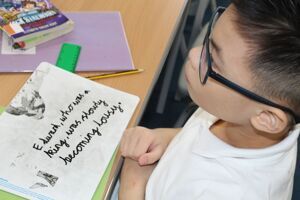 This runs throughout the school from Year 2 all the way to Year 6 and as the name says, it happens every day! Daily Reading is our way of teaching reading in a fun and engaging way as we encourage pupils to ask questions and discuss what they are reading in order to help them become expert readers. Our Daily Reading sessions are extremely interactive and we expect to hear a ‘learning buzz’ in every classroom as children discuss, debate and practice their fluency through choral and echo reading.
This runs throughout the school from Year 2 all the way to Year 6 and as the name says, it happens every day! Daily Reading is our way of teaching reading in a fun and engaging way as we encourage pupils to ask questions and discuss what they are reading in order to help them become expert readers. Our Daily Reading sessions are extremely interactive and we expect to hear a ‘learning buzz’ in every classroom as children discuss, debate and practice their fluency through choral and echo reading.
Reading Journey
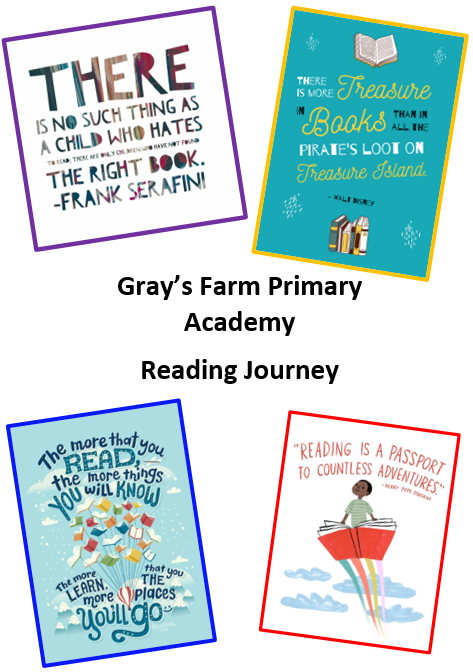
Reading in Nursery
As soon as your child enters nursery with us at Gray’s Farm we begin having discussions about the sounds they hear around them. This means helping them to identify and isolate specific sounds within the environment such as animal noises, a car horn and people laughing. We encourage body percussion through clapping and stamping as well as enjoying rhyming songs and stories together. Many of the games and activities within the classroom include strategies to support visual memory and fine motor skills, all of which form part of early literacy skills. When your child is ready, they are encouraged to hear the initial sound in words and begin using the RWI (Read Write Inc Phonics) strategies that they will become very familiar with once in Reception.
To encourage reading, we tell stories using puppets, props, as well as picking from a selection of storytelling hats. Children use resources to retell stories, and have access to a range of non-fiction texts; for example, having DIY/toy catalogues in our role play areas. As well as this, torches and finger lights are used by the children to highlight texts and pictures which they really enjoy. Story sacks and the class reading bear play an integral role in nursery and the children love being chosen to take them home each week. Furthermore, story sessions are added to tapestry along with questions for parents to check their child's understanding.
Reading in EYFS and Key Stage 1
At Gray’s Farm, reading is taught through ‘Read Write Inc Phonics’ (RWI) from the start of Reception. We begin by teaching the graphemes (sounds) to go along with the sounds your child has already started to identify in words. Firstly, they learn one way to read the 40+ sounds and blend these into words, and then they learn to read the same sounds with alternative graphemes. Your child will read in 1:1 and small groups depending on the learning needs of the child.
Our children love learning to read through RWI and we love to watch their confidence and love of reading grow from the start. Phonic books are closely matched to their increasing knowledge of phonics and ‘tricky’ words and, as children re-read the stories, their fluency increases. Along with a thought-provoking introduction, prompts for thinking out loud and discussion, children are helped to read with a storyteller’s voice.
When using RWI your child will:
- learn 44 sounds and the corresponding letter/letter groups using simple picture prompts
- learn to read words using Fred Talk
- read lively stories featuring words they have learned to sound out

Similarly to Nursery, Reception continue to use story sacks and reading bears with the children; all of the children love having the opportunity to take them home and retell the stories to their family, and of course to the reading bear!
Furthermore, our role play areas encourage a love of reading as children often have the opportunity to retell and act out the stories they have read as well as recite facts they’ve learnt from our non-fiction books whilst in role as palaeontologists (for example).
Your child will take home several reading books each week, including one at their individual level, which they are encouraged to read to an adult, as well as books from the book corner which are for them to enjoy as a family.
Reading in Key Stage 2
Throughout Key Stage 2, reading accuracy and comprehension skills continue to be taught through Daily Reading. However, for those that need it, we continue to support the development of children’s phonological knowledge and understanding through small group and 1:1 phonics interventions.
Daily Reading takes place every day; the children will work as a whole class, in groups, in pairs and individually to discuss and unpick the text.
Throughout Key Stage 2, whole class reading becomes fully embedded within our daily reading lessons. Within these lessons, children are continually exposed to high quality literature, have the opportunity to develop their fluency and are encouraged to explore their skills in thinking aloud and internally whilst reading. In order to become more analytical, written responses to evidence-based questions and book talk are modelled and analysed before children apply this process independently.
During daily reading lessons, children will be taught several different aspects of reading including: vocabulary, prior knowledge, whole class discussion, fluency and explicit teaching of comprehension strategies.
Vocabulary
In order to fully comprehend a text, children need to have a secure understanding of at least 95% of the vocabulary within it. Every lesson will include a consistent approach to teaching vocabulary across the school with teachers following a script to ensure children can understand unfamiliar words within the lesson’s text.
Prior Knowledge
Accessing children’s prior knowledge or giving children the prior knowledge needed to understand a text is paramount in developing children as readers. Without this, children will struggle to make connections and understand the context in which characters and stories are set. When introducing a new text, fiction or nonfiction, teachers will provide the background information needed for children to be able to fully comprehend.
Whole class discussion
C Warner states that, ‘If we learn to decode through reading, we learn to comprehend through talk.’ Therefore book talk is essential to ensure that our children take part in open discussions about high quality, worthwhile texts; subsequently developing their ability to read critically and deepen their understanding and therefore appreciation. Children are encouraged to build and challenge their peer’s ideas, using evidence from the text to support their opinions. This is also an opportunity for children to explore and justify their opinions, make connections, summarise, ask questions and make predictions.
Fluency
Our fluency lessons within Daily Reading, enable children to hear an expert model engaging intonation, expression, accuracy and automaticity. Children learn how to echo and choral read, rehearse text with a partner and then use their fluency to aid their comprehension.
Whole School Reading
Every day the children listen to their teacher reading the Whole Class Book which provides children with the opportunity to hear a variety of high-quality texts being read aloud and discussed. Both the children and the teacher are involved in choosing the texts and chosen texts are then placed in their Star Book holder so that children can not only see their current class text but also what else they’ll be reading over the coming weeks.
The texts used will cover both fiction and non-fiction and include:
- Extracts
- Novels – both modern and classic
- Short texts
- Newspaper articles
- Song lyrics
- Video clips
- Poetry
​​As well as this, every day all children take part in independent reading which we call Simple View of Reading; a time for children to really relax and get stuck into a book type they love for an extended period of time. During this time, class teachers spend time with individual children, talking to them about their book, listening to them read as well as discussing any struggles that they are having with reading.
At Gray’s Farm, with the children’s input we continually invest in our library to provide children of all abilities with a wealth of books that will excite, inspire and develop children to become life-long readers. All classes have access to the library once a week, as well as it being open every day before school.
All classrooms have an enticing book corner full of books that are matched to the levels and interests of the children within their class. These books are frequently swapped with those from the library so that children have an ever-changing selection of books to choose from. As well as this, we have school librarians who work together with the reading lead to ensure that we have books that match all of the children’s interests. Each librarian acts as an advocate for their class by bringing book suggestions or recommendations to the librarian’s weekly meeting so that they can then be purchased.
Each week the whole school enjoys a Reading Assembly. This is an opportunity for teachers to recognise and celebrate Star Readers, for the children to take part in our Masked Reader competition and for new additions to the library to be shown to the school. Our children love the Reading Assembly; it is something that the whole school looks forward to each week!
Finally, to aid our staff with the planning of Reading and to ensure that we not only meet but exceed the National Curriculum objectives we use the Gray’s Farm Reading Overview. This includes an overview of the books that each year group will use throughout the year. These book choices have been carefully considered to ensure that our texts are diverse, engaging, relevant, cross curricular and progressive. As well as this, our book spine is constantly being adapted to meet the needs and interests of our pupils.
SEND - Ambition and Access in Reading
| Ambition – What are we aiming for children with SENs to achieve in this subject? | Access – What amendments are made to the subject in order to help children with SENs to achieve? |
| By the time children leave Gray’s Farm they are able to read for enjoyment as well as having an understanding of what they are reading so that they can be successful in everyday life. |
|
SEND - Ambition and Access in Read Write Inc
| Ambition – What are we aiming for children with SENs to achieve in this subject? | Access – What amendments are made to the subject in order to help children with SENs to achieve? |
| We believe that reading opens the door to learning and therefore it is vital that we as educators do everything we possibly can to ensure that EVERY child will learn to read. We are determined to teach every single child to read, regardless of their background, need or abilities. SEN pupils are involved in the RWI lessons, as all pupils work in ability groups and teaching is geared to the speed of progress of each group. |
|